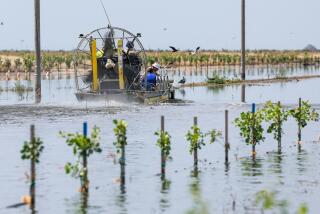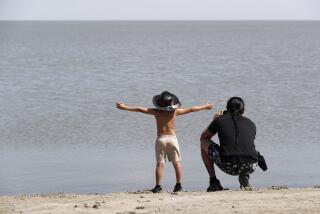Spreading the Noose : Convict Lake, Site of a Shootout Between Prison Escapees and a Posse in 1871, a Popular Paradise for Sierra Anglers
- Share via
MAMMOTH LAKES — It is probably safe to assume that Moses Black and Leander Morton did not appreciate the beauty of nearby Convict Lake.
But then, they were busy dodging bullets and, later, having their necks stretched.
The two outlaws were part of a gang of 29 who overpowered guards and escaped from Nevada State Penitentiary on Sept. 17, 1871, and part of a group of six chased by a determined posse into the foothills of the Sierra south of here.
After a dramatic shootout with the posse tracking them to what is now Convict Creek, Black, Morton and J. Bedford Roberts escaped south toward Bishop. Three others had split from the group shortly before the shootout.
The law caught up with Black, Morton and Roberts on Sept. 27. According to George Williams III’s “The Murders at Convict Lake,” Black and Morton were “lynched, tried and hung” by vigilantes who wrestled them from the posse. The convicts had killed Billy Poor, a young mail carrier, during their escape. Black also had killed posse member Robert Morrison during the shootout. Roberts, believed to have played only a minor role in the killings, was turned over to the posse and returned to prison.
Such is the history behind the naming of the lake. But what’s in a name?
Convict Lake could still bear its former moniker, Diablo Lake, and it wouldn’t change the fact that it is one heavenly reservoir, surrounded by aspens and pines and steep granite peaks, and brimming with clear, cold water teeming with trout. It is the home of Horgon, a giant German brown that heretofore has eluded a persistent posse armed not with six-shooters and Henry repeating rifles, but with rods and reels and every lure and bait known to man.
*
A glacier slicing through the region thousands of years ago carved what is now Convict Lake, tucked in the mountains at 7,583 feet at the end of Convict Lake Road only two miles from U.S. 395 between Bishop and Mammoth Lakes. The lake, or tarn, is one of the deepest in the Eastern Sierra at 140 feet. The water is so clear you can follow the rays of the sun to depths of 30 feet or more.
On cloudy days, the surface of the lake acts as a mirror, reflecting not only the billowy clouds but the steep mountains that rise sharply to heights of 10,000 feet or more. The 12,268-foot Mt. Morrison, the highest visible peak, towers over the lake on the south shore and Mt. Laurel, at 11,813 feet, reaches up dramatically from the northeast.
“This is God’s country,” said Canoga Park’s Rod Lenox, 38, a Convict Lake regular who knows an appropriate cliche when he sees one. “The first time we came up, we went to Crowley (Lake, a few miles down U.S. 395) and froze our butts off. We found this lake by mistake, looking at the map. Ever since then we’ve been coming up here.”
Mt. Morrison was named after Robert Morrison, Black’s victim during the shootout. Morrison, a 34-year-old Wells Fargo agent and posse member, reportedly had Black in his sights during the shootout. His gun failed, however, and Black, “a large and heavy man with dark hair and beard,” walked up and “coolly pointed his gun at the back of Morrison’s head and fired . . . killing him instantly,” according to Williams.
The posse, one of its members killed and two wounded, fled the scene. A new posse formed in Bishop, caught up with the three close to Round Valley near Bishop and for Black and Morton it was soon to be curtains.
That was all more than 100 years ago, but some wonder if the region isn’t haunted by ghosts of those who met such violent ends here, especially when the wind whistles in fast and cold through the mountains and canyons.
“The wind that blows here almost has life of its own,” said Adrienne DeSurra, who with her husband, David, operates Convict Lake Resort. “It has a sound to it . . . like a spirit or something.”
*
The haunting wind and lore of the Wild West add to the mystique of Convict Lake, but they are not what bring thousands here each year. When the snow begins to melt and the ice thaws on the lake, usually in mid-April, the campground, with 88 sites at the foot of Mt. Morrison along Convict Creek, begins to fill.
And on the last Saturday of April, which marks the beginning of the fishing season, the only things that can be found dangling at the end of a rope at Convict Lake are trout on a stringer.
This year’s season-opener on April 30 was so successful that David DeSurra barely had time to catch his breath, as anglers young and old hauled stringers of fish into the general store to have them weighed and photographed.
There were no monsters, but plenty of three- and four-pounders, and a few pushing five. Even 8-year-old Zach Haines of Ventura, on his first Eastern Sierra opener, had no trouble filling a stringer. He did, however, have a little trouble dragging his trout and those of his father, Randy, into the store.
Confronted by a reporter, Haines became red-faced and mum, until he was asked who had caught the two larger rainbows on the string, the tails of which were dragging on the ground.
“I caught all the big fish,” the youngster said.
Convict Lake is small--about a mile long and half a mile wide--but it is constantly fed by underground streams and the higher back-country lakes in the John Muir Wilderness. Its depth of 140 feet, according to DeSurra, “gives those big trout plenty of room to hide out in.”
The biggest fish taken from Convict Lake was a 19 1/2-pound German brown in 1956. The biggest in the last 25 years was a 14 1/2-pound brown on Oct. 17, 1993, which was also the biggest trout caught in the Eastern Sierra last year. Kevin Green of Ontario used a cluster of salmon eggs to entice the fish near where the lake flows into Convict Creek. After a lengthy fight, Green netted the fish, but it took off, ripping the net from his hands and pulling it downstream. Green ran in after the net, grabbed it and subdued the fish.
But there is one big fish that has yet to be caught, according to longtime outdoor writer Tom Stienstra, who in his book, “California Fishing,” gave this description of his first visit to Convict Lake: “My mouth dropped like an egg from a long-legged chicken.”
Stienstra, reached this week at his Northern California home, recalled the day he saw a brown trout estimated at 15-20 pounds:
“Right at dusk, when all the people were leaving and all the birds and all the deer and wildlife were coming out at once, I saw this brown trout jump not more than 20 feet from my canoe. Twenty seconds later I got a strike, and I just about levitated out of the boat.”
Stienstra was unable to hook the fish, however. About two weeks later, he caught three brown trout, “all six- to seven-pounders, but none even half the size of the one that jumped.”
Stienstra named the elusive brown Horgon.
“It was the first name to pop into my head,” he said.
*
Less than two months after the wagon supporting Black and Morton was driven out from under them, leaving them hanging, 18 of the 29 escapees had been captured and all but one of the other escapees was eventually caught. Black and Morton were the only ones hanged. Roberts, who had been serving time for stage robbery, was found not to have received a fair trial and was released in 1873.
Since then, three movies have been made about the prison break and ensuing chases, DeSurra said.
Around here these days, however, the only hanging is being done by fishermen slipping trout onto a stringer. It could be only a matter of time for Horgon.
More to Read
Sign up for The Wild
We’ll help you find the best places to hike, bike and run, as well as the perfect silent spots for meditation and yoga.
You may occasionally receive promotional content from the Los Angeles Times.






